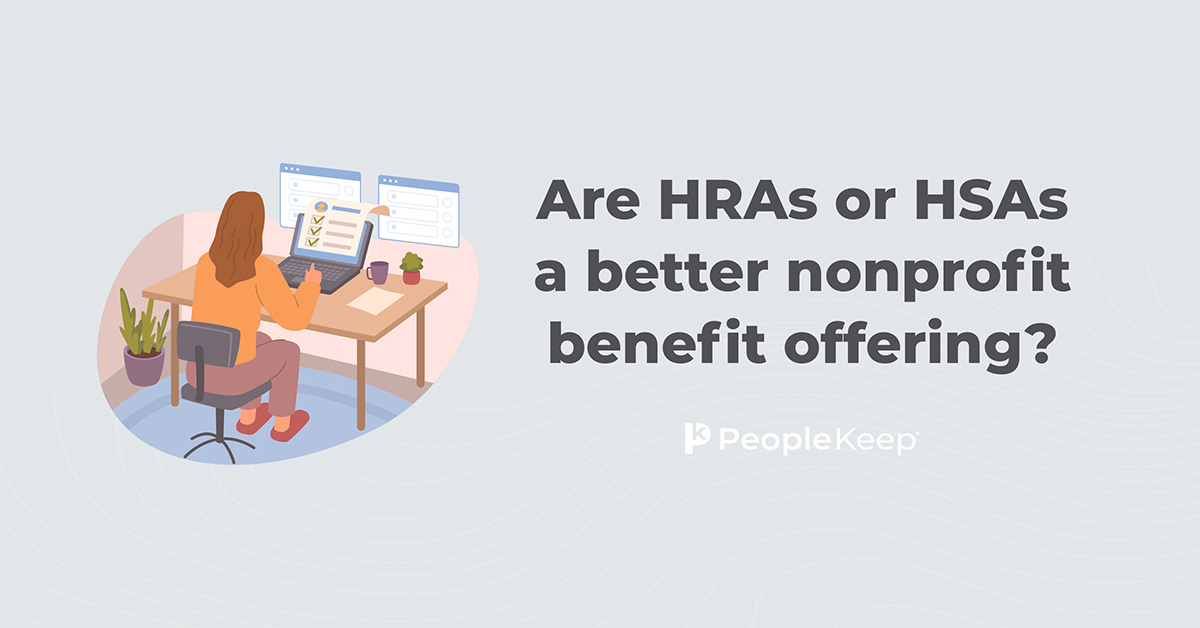High deductible health plan cost & savings
By Elizabeth Walker on August 14, 2023 at 9:24 AM
When considering different types of health insurance policies for your organization, you may have wondered if it’s better to have a low deductible health plan (LDHP) or a high deductible health plan (HDHP). While HDHPs have higher deductibles than LDHPs, as the name implies, there are benefits to taking on the risk.
HDHPs can come with significant savings for employers and employees, especially if you maximize them. According to the 2023 KFF Employer Health Benefits Survey1, 29% of covered workers had an HDHP with a savings option. Additionally, 29% of small employers and 57% of large employers chose HDHPs with added savings options, such as a health savings account (HSA) or a health reimbursement arrangement (HRA).
In this blog post, we’ll cover the pros and cons of HDHPs and how you can supplement this type of traditional health plan for an even better benefit.
What is a high deductible health plan?
As the name implies, an HDHP is a health insurance plan with a high deductible that individuals must meet before the insurer covers qualified expenses. Because of its higher deductible, an HDHP has lower monthly premiums than an LDHP.
A health plan must meet specific criteria for the government to consider it an HDHP.
The Internal Revenue Service currently defines an HDHP as:
- Any health insurance plan with a minimum deductible of $1,500 for individual coverage or $3,000 for family coverage.
- A plan where the out-of-pocket maximum is $7,500 for individual coverage or $15,000 for family coverage, including deductibles, copayments, and coinsurance.
- Once you meet your out-of-pocket limit, the plan will pay 100% of your covered costs for the rest of the plan year.
HDHPs can be great for those who want to save money while maintaining coverage for unforeseen medical emergencies and health events. Employees may only be on the hook for premiums and the occasional medical expense.
According to the Affordable Care Act (ACA), all HDHPs bought through the federal health insurance marketplace must cover certain preventive services at an in-network provider, no matter how much of your annual deductible you've paid. Service providers may charge your employees for preventive services if they receive out-of-network care or have a grandfathered health plan.
The preventive care services that HDHPs may cover include:
- Doctor visits for annual physical exams
- Immunizations
- Routine prenatal care and well-child visits
- Screening services for things like cancer, heart disease, pediatric conditions, and vision and hearing disorders
- Tobacco cessation programs
- Obesity weight-loss programs
Advantages of an HDHP
If you already offer a group health plan with a low deductible, switching to an HDHP is a great way to mitigate the rising cost of health insurance premiums year-over-year. Higher annual deductibles mean lower premiums for small businesses trying to find ways to save on medical costs.
Enrollees in HDHPs have the following advantages:
- A lower monthly premium than LDHPs.
- A wide variety of providers and health plan types.
- People who rarely use their health benefits may save money.
- Out-of-pocket expenses aren’t the market rate. Instead, they’re the negotiated rate between the healthcare provider and the insurance company.
- Can integrate with tax-advantaged funds like HSAs and HRAs.
If you have a generally healthy workforce, an HDHP may be the best type of group health insurance plan you can get. HDHPs make good insurance plans for young and single employees with a good health status who don't need coverage for spouses and dependents. However, these benefits only apply if your organization can meet the requirements for a group health plan.
Downsides of an HDHP
HDHPs provide a considerable opportunity for small businesses to save money because of their lower premium costs. Problems may arise, however, when employees face costly medical expenses and must pay more out-of-pocket upfront before their insurance coverage is available.
In a 2023 KFF survey2, one in four U.S. adults said they put off or skipped medical care in the past year because of the cost. Because HDPHs require individuals to pay for more medical expenses before they meet their deductible, some people with an HDHP might not get necessary medical help because they can’t afford it.
The following are some potential disadvantages of HDHPs:
- Deductible amounts can be very high for individuals and families.
- Those who suffer from a chronic condition have high out-of-pocket medical costs.
- Most healthcare expenses, other than preventive services, are entirely out-of-pocket until the participant reaches the deductible.
- Some employees may avoid care for fear of the high medical costs.
Because of these concerns, HDHPs typically don’t provide enough coverage for those with chronic medical conditions, those who need critical care, or families and children requiring frequent doctor visits. If this is the general makeup of your workforce, an HDHP may not be the best choice.
Additionally, there may still be cheaper and more flexible benefits options available to your organization.
How much does a higher deductible health plan cost?
Many factors impact the price of your HDHP premiums, such as state and federal laws, where you live, and the type of plans available, which aren’t within your control.
When choosing an insurance plan, it’s a good idea to think about your employees’ total potential healthcare costs, not just their premiums. Considering this, you can see if selecting a higher deductible health plan would be the best bang for your buck.
Of course, it’s impossible to predict the exact amount of total medical services your employees may need in a given year. A good place to start is by calculating what you and your employees’ monthly premium costs will be.
According to KFF, the average annual premiums for covered workers enrolled in HDHPs in 2023 were $7,753 for single coverage and $22,344 for family coverage. These costs are typically split between you and your covered employees, but the share every organization pays is different.
| Plan type | Individual coverage average annual premium | Family coverage average annual premium |
| Low deductible health plan | $8,435 | $23,968 |
| High deductible health plan | $7,753 | $22,344 |
Before you pick the HDHP that’s right for your business, you should consider healthcare cost averages, the diversity and general health affairs of your workforce, inflation prices, your health benefits budget, and other controlling factors to the best of your ability.
How to supplement your high deductible plan
At this point, you may wonder how to offset some of your employees' costs with an HDHP. Despite its lower monthly premiums, the challenge with an HDHP is how expensive healthcare can become when your employees need it.
To help lessen the blow of an unexpected out-of-pocket cost, you can pair HDHPs with supplemental health benefits to pay for eligible expenses, such as integrated HRAs, health insurance stipends, or HSAs.
Let’s take a closer look at each of these benefits below so you can better understand how they work for employers.
Integrated HRA
If you’re looking to lower overall healthcare costs and lessen the high deductible impact of your HDHP, an integrated HRA, also known as a group coverage HRA (GCHRA), can help.
You can integrate a GCHRA with a traditional group health insurance plan, including HDHPs. Employers use this type of HRA to supplement the group insurance health plan by reimbursing employees tax-free for eligible expenses not fully paid for by their health plan.
Many employers pair an HDHP with a tax-advantaged fund like HSAs or HRAs to offer additional savings to their employees. Examples of eligible expenses include copays, coinsurance, and expenses paid before an employee meets their deductible.
KFF found that 8% of organizations that offered health benefits in 2023 provided an HDHP with an integrated HRA. The 2023 KFF benefits survey also found that 34% of covered workers with an HDHP and an integrated HRA received contributions that, if applied to their deductibles, would reduce their personal annual healthcare liabilities to less than $1,000.
Overall advantages of an integrated HRA include the following:
- You can keep your HDHP but provide extra benefits through reimbursement.
- You can attract potential employees and retain key talent with a more attractive HDHP-supplemented benefit.
- You can customize this health benefit by setting unique cost-sharing options, like requiring an explanation of benefits (EOB). You can also differentiate eligibility and allowances by employee classes.
- The only employees eligible for the integrated HRA are those on your employer-sponsored health plan.
- Unlike HSAs, there’s no maximum contribution limit with an integrated HRA. So you can choose a budget-friendly allowance for your organization.
- Employers only pay reimbursements through an integrated HRA when an employee submits a qualifying expense, so there’s no pre-funding needed. If your employees don’t use their full allowance by the end of the plan year, the remainder goes back to you.
Many employers use GCHRAs with HDHPs for more significant cost savings. But they work with any group health plan, including an LDHP.
Integrated HRAs are an excellent option for employers looking to keep their HDHP for the lower premium while keeping the employee’s traditional plan the same, if not better, by enabling reimbursement capabilities.
Health stipend
Over the past few years, some small employers have started using health stipends to supplement their group health insurance plans.
With a health stipend, employees receive a fixed, taxable allowance to purchase out-of-pocket costs that meet their needs, such as prescription drugs, preventive services, and other medical procedures.
This extra taxable money can also help employees pay for items that insurance won’t cover until they reach their deductible or items the group plan doesn’t cover.
Employer contributions are typically added to the employee's paycheck as wages on a recurring basis. But you can also offer a stipend through a reimbursement model. Like an integrated HRA, employer contributions to a stipend are unlimited, so you can pick an amount that works for your budget and your employees.
Overall advantages of a health insurance stipend include the following:
- They bridge the gap between items not included in the group health insurance plan.
- They have fewer compliance or regulation considerations with the IRS, HIPAA, or ERISA.
- They’re simple and easy to manage through automatic payroll additions.
- If you offer a health stipend through a reimbursement model, you only make payment when an employee submits an expense, so no pre-funding is needed.
The flexibility of health stipends is what is propelling them into recent popularity. And because they work with any group plan, you reap the benefits of low HDHP premiums while giving your employees added funds to pay for additional medical care and services.
Health savings accounts (HSAs)
HSAs are tax-advantaged savings accounts where money accrues on a pre-tax basis for account holders to use on medical services and other qualifying out-of-pocket expenses.
The employer and the employee can contribute to the HSA if the combined employee and employer contributions don’t exceed the annual contribution limit. Regardless of where HSA contributions came from, the individual employee always owns the account.
Overall advantages of an HSA include:
- Contributions an employee makes to their HSA are tax-deductible.
- All excess contributions remain in the HSA indefinitely.
- There's no vesting schedule or penalty if the account holder doesn’t spend the money.
- Excess contributions automatically roll over into the following year.
- Withdrawals used to pay for qualified medical expenses for your employee, their spouse, and their dependents are never taxed.
- The account is portable, meaning the employee can keep it forever—even if they quit or retire.
Offering an HSA and an HDHP helps ease an employee's financial burden, especially if the business makes additional contributions to the account. It’s important to note that with HSAs, you must have an HSA-qualified HDHP to make employer contributions to your employees’ savings accounts.
Alternatives to HDHPs
While HDHPs can help you lower your healthcare premiums, they’re still a type of group health insurance plan. Smaller organizations may still struggle to meet minimum participation requirements or monthly premiums. Thankfully, there are alternatives available.
Stand-alone HRAs like the qualified small employer HRA (QSEHRA) and individual coverage HRA (ICHRA) allow employers to reimburse their employees for qualifying medical expenses, including individual health insurance premiums. This gives businesses of all sizes a more affordable and flexible health benefit without sacrificing quality.
Conclusion
Because of their lower premium costs, HDHPs are a popular plan option for employers and employees. While there’s no doubt that they can offer huge savings, they may not always be the right fit for your business.
If you want to expand your HDHP's value, offering it alongside an integrated HRA or a health stipend is best. If you want to offer a more flexible benefit than a group plan, a QSEHRA or ICHRA is often a better option. If you’re ready to implement one of these benefits for your company, contact a PeopleKeep personalized benefits advisor, and we’ll get you started right away.
This article was originally published on May 28, 2020. It was last updated on March 1, 2024.
1. https://files.kff.org/attachment/Employer-Health-Benefits-Survey-2023-Annual-Survey.pdf
2. https://www.kff.org/health-costs/issue-brief/americans-challenges-with-health-care-costs/
Check out more resources
See these related articles

Are HRAs or HSAs a better nonprofit benefit offering?
HRAs vs. HSAs: Which nonprofit benefit option should you choose? Dive into this article to see the differences and make the best decision for your organization.

How to tell if your HDHP is HSA-qualified
Not sure if your high deductible health plan is HSA-qualified? This article explores how to determine if you're eligible for a health savings account.

History of U.S. Health Insurance - Why Most Americans Get Health Benefits from Employers
Prior to World War II, most Americans paid for their own medical care, either directly to their chosen provider or through Blue Cross nonprofit healt



